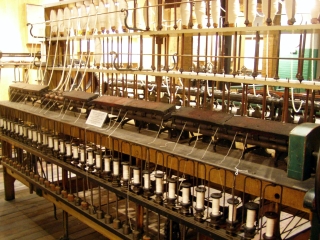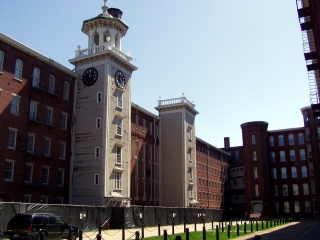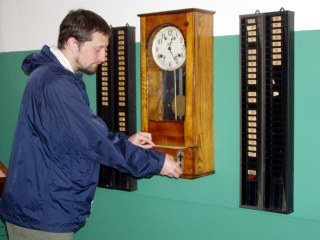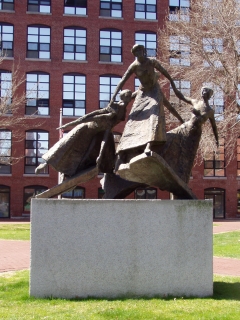Lowell National Historical Park
Lowell, Mass.
Visited: April 20, 2004
NPS Site Visited: 28 of 353
NPS Website; Local Website.
 WHAT IS IT? WHAT IS IT?
Essentially downtown Lowell, Massachusetts. The park commemorates the American Industrial Revolution through the example of the textile mills of Lowell.
BEAUTY (4/10)
Lowell National Historical Park exists around and within the redbrick rectangular textile mill buildings of Lowell. The buildings have not been knocked down; they have just been gutted and used for other purposes, such as museums, housing, business and commerce. It is remarkable to see an American city that has adapted the buildings of the past for usage instead of demolishing them.
HISTORIC SIGNIFICANCE (8/10)
Both the Blackstone River Valley National Heritage Corridor and Lowell NHP claim to be the start of the American Industrial Revolution. The truth does not matter. The concept began in Great Britain and slowly appeared throughout the North. Nonetheless, the Industrial Revolution is one of the greatest changes our world has ever seen; perhaps the last change that actually deserves the oft-used descriptor: revolution. Lowell NHP is a wonderful place to study and understand the Industrial Revolution’s birth in the United States.
CROWDS (6/10)
We had much of the Park to ourselves. There was a group of school kids aged about 5th Grade but they did not bother us.
 EASE OF USE/ACCESS (4/5) EASE OF USE/ACCESS (4/5)
The park is easily located from many well-marked brown NPS signs off both US Interstate 495 and Massachusetts Route 3. Parking is free for five-hour stretches in a large lot near the Visitor Center. We spent nearly that amount of time in Lowell. We can’t believe it either.
The Park Service offers three ways to access the various buildings at Lowell NHP: 1) Pleasant short walks along Lowell’s streets; 2) Restored trolleys that travel from site to site; 3) Boat tours along the mill canals. Walking was our only available option. The trolleys were out for repair and the boats do not run until Memorial Day.
Nearly all buildings are wheelchair accessible.
CONCESSIONS/BOOKSTORE (4/5)
Great selection of mill-related books as well as cloth made in the museum.
COSTS (3/5)
There is a $4 charge for the Boott Cotton Mills Museum. Well worth it.
RANGER/GUIDE TO TOURIST RATIO (5/5)
Although we were not on a guided tour, we ended up spending about a half hour each with two different Rangers on the second floor of the museum. They both gave thorough explanations of every exhibit and answered a multitude of questions regarding Lowell, the Industrial Revolution, immigration, trade, slavery, strikes, economics, whatever.
TOURS/CLASSES (10/10)
One of the National Park Service's best educational experience. There are two fantastic “award-winning” 20-minute films. Lowell: The Industrial Revelation, a film specific to Lowell’s place in history, shows every half-hour at the Visitor Center. A different film, done by the same film team as Lowell…, shows at the Boott Mills Museum. It is a tremendous explanation of the American Industrial Revolution in the 19th century, one that surprisingly does not talk down to its audience.
 The film even brings up the sordid relationship between the mill bosses and their suppliers: the slavery-based cotton plantation industry of the South. We did not expect that. Nearly every Site, except for the National Constitution Center, we have gone to in the North has shied away from the topic of slavery. Why isn’t there an Underground Railroad National Historic Site? It makes no sense. The film even brings up the sordid relationship between the mill bosses and their suppliers: the slavery-based cotton plantation industry of the South. We did not expect that. Nearly every Site, except for the National Constitution Center, we have gone to in the North has shied away from the topic of slavery. Why isn’t there an Underground Railroad National Historic Site? It makes no sense.
The ticket to enter the Boott Mills Museum is a timecard. When you enter you punch in on an actual machine used by the former mill workers. The first floor consists entirely of an operating weaving room. 88 working power looms in all. You hear the roar of the machines. You can even purchase cloth made at the loom in the bookstore. The second floor explains the weaving process from its start to its conclusion through numerous exhibits, interactive displays and videos. Children’s displays are set up to show each stage of production. The explanations are short, illuminating and effective for all ages.
Lowell Blues, a documentary on Jack Kerouac, Lowell native and author of On the Road, shows daily at the Visitor Center. Lowell NHP includes everyone from the famed mill women of Lowell to the waves of immigrants who followed them in the mills. Jack Kerouac was a first generation Canadian American, son of a textile worker. He is Lowell; therefore, he is a part of the Park. The Park is a history not just of the Industrial Revolution and its industry but also of the people who fueled it.
Next door to the Boott Museum is the Morgan Cultural Center. Included is an exhibit showing a typical Boarding House for the female mill workers in the early days of the Mill as well as an exhibit on the immigrations into Lowell. Great stuff.
FUN (8/10)
The Site actually does make the Industrial Revolution and the workings of a textile mill fun. Fun is achieved through the interactive displays, movies, and terrific Rangers.
 WOULD WE RECOMMEND? (8/10) WOULD WE RECOMMEND? (8/10)
We expected another nebulous city National Historical Park (like New Bedford NHP and Salem NHP) with hidden costs and little historical attraction, created only to bring tourism to a blighted industrial northeast city. Boy, were we wrong.
Lowell NHP is a terrific living and working museum. It is a celebration of our industrial history and a celebration of the city of Lowell. We love learning. Not everyone does. Be forewarned, most of the excitement here is cerebral. Still, it is nice to see that the National Parks people have done it right. The Site is affordable, informational and educational.
TOTAL 60/80
|